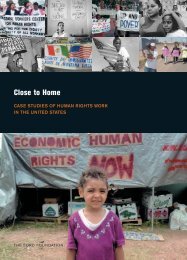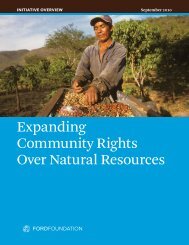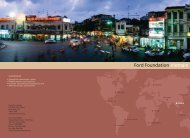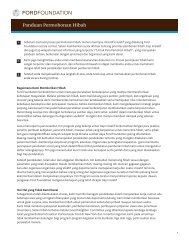Inclusive Scholarship: Developing Black Studies - Ford Foundation
Inclusive Scholarship: Developing Black Studies - Ford Foundation
Inclusive Scholarship: Developing Black Studies - Ford Foundation
You also want an ePaper? Increase the reach of your titles
YUMPU automatically turns print PDFs into web optimized ePapers that Google loves.
<strong>Inclusive</strong> <strong>Scholarship</strong>: <strong>Developing</strong> <strong>Black</strong> <strong>Studies</strong> in the United States 29<br />
Crisis of Establishment<br />
Between 1966 and 1970, most American colleges and universities added to<br />
their curricula courses on Afro-American life and history, and most made<br />
efforts to include <strong>Black</strong>s on their faculties and administrative staffs. The fact<br />
that schools like Macalester, Bowdoin, Colby, Reed, Dartmouth, and Carleton<br />
(to pick just a few names), which were relatively free of pressure,<br />
joined the rush argues that there was something more to explain it than the<br />
threat of students disrupting academic life. Like all other aspects of the<br />
movements for peace and civil rights, the demand for university reform by<br />
<strong>Black</strong> students was national in its impact as well as local in particular manifestations.<br />
In some sense, the urge for change was everywhere; whether or<br />
not a campus had militant <strong>Black</strong> students making demands, the urge for reform<br />
was in the air.<br />
I suggest three motives, independent of immediate student pressure,<br />
that compelled college administrators and faculty to join the march for<br />
change. First, there was, particularly among liberal-minded academics, a<br />
genuine sense of American higher education’s complicity in the social inequities<br />
resulting from racism-indifference to <strong>Black</strong> undergraduate enrollment,<br />
insensibility to non-White subject matter in the curriculum, and the<br />
discouragement of <strong>Black</strong> scholars. Second, it had become fashionable to<br />
bring <strong>Black</strong>s onto staffs and faculties, just as it had earlier become fashionable<br />
to recruit “hardcore, inner-city kids” for admission. The sense of competition<br />
among institutions should not be discounted; the legitimate<br />
purpose of the act too often was joined by the wish to do at least as well as<br />
comparable institutions. Third, in their effort to attract the “best” applicants<br />
from a generation of teenagers noted for their social consciousness,<br />
college administrators felt it important to look reasonably open to change,<br />
to appear to be progressive without compromising integrity. A course or<br />
two on <strong>Black</strong> history or culture could achieve that end.<br />
The great majority of institutions added courses pertinent to Afro-<br />
Americans and, as a direct result or not, experienced little or no student disruption;<br />
most changes involved merely a course or two and could hardly be<br />
called a program in <strong>Black</strong> <strong>Studies</strong>. Yet, from 1966, student disorders were

















